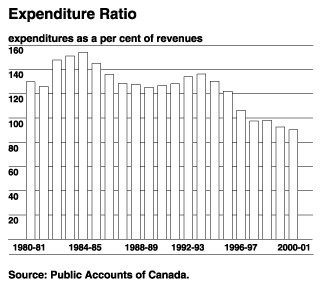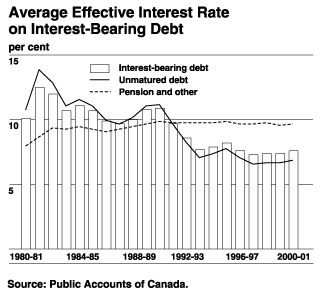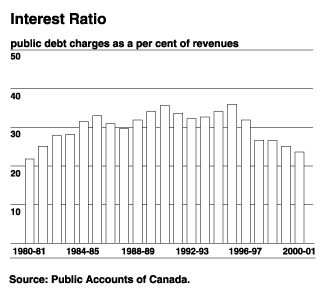|
|
|
|
|
|||||||
|
|
Annual Financial Report 2000-2001: 3
- Table of Contents - Previous - Next -
Budgetary Expenditures
Table 3 on page 16 presents budgetary expenditures on both a gross and net basis. The differences are identical to those between gross and net budgetary revenues.
Net budgetary expenditures amounted to $161.4 billion in 2000-01, up $8.0 billion, or 5.2 per cent, from 1999-2000. The expenditure ratio – net budgetary expenditures as a percentage of net budgetary revenues – stood at 90.4 per cent in 2000-01, down from 92.6 per cent in 1999-2000. In 1993-94 the expenditure ratio stood at 136.2 per cent.

The largest component of budgetary expenditures is public debt charges, representing 26 per cent of total expenditures. Public debt charges increased by $0.4 billion, or 1.1 per cent, in 2000-01. They are affected by interest rate changes as well as by the stock and composition of interest-bearing debt.
- The average effective interest rate on the Government’s interest-bearing debt (unmatured debt and pension liabilities) was 7.6 per cent in 2000-01, compared to 7.4 per cent in 1999-2000. The average effective interest rate on unmatured debt was 6.9 per cent while that on pension and other accounts was 9.7 per cent.
- The stock of total interest-bearing debt declined by $8.7 billion in 2000-01, from $597.9 billion to $589.2 billion, as the stock of market debt declined by $10.0 billion to $446.4 billion, while liabilities to pension and other accounts increased by $1.3 billion to $142.8 billion. Since 1993-94 the share of market debt has declined by over 4.5 percentage points with a corresponding increase in the liabilities for pension and other accounts. Within market debt, the share of marketable bonds has increased by over 20 percentage points, while that for Treasury bills and Canada Savings Bonds has declined.

The interest ratio – public debt charges as a percentage of net budgetary revenues – declined from 25.1 per cent in 1999-2000 to 23.6 per cent in 2000-01. This ratio means that, in 2000-01, the Government spent about 24 cents of every revenue dollar on interest on the public debt. This is down from the peak of 36 cents in 1995-96 and is the lowest this ratio has been since 1981-82. This is money that must be paid to meet the Government’s obligations on its debt. The lower the ratio, the more flexibility the Government has to address the key priorities of Canadians.

It is worth noting that public debt charges are presented on a gross basis. Yet some of the borrowings undertaken by the Government give rise to a corresponding asset – for example, borrowings undertaken for the Exchange Fund Account. These assets earn interest, which are reported as "return on investments" as part of budgetary revenues. Netting these returns would lower public debt charges by $6.1 billion in 2000-01. On this basis, "net" public debt charges would have declined by $0.4 billion between 1999-2000 and 2000-01.
Net program spending – net budgetary expenditures less public debt charges – amounted to $119.3 billion in 2000-01, an increase of $7.6 billion, or 6.8 per cent, from 1999-2000. The program share – net program spending as a percentage of net budgetary revenues – amounted to 66.8 per cent, down slightly from 1999-2000. In 1993-94 the program share was 103.5 per cent.

Within program spending, major transfer payments to persons increased by $2.4 billion, or 7.1 per cent, primarily reflecting the one-time relief payment for heating expenses and higher elderly benefit payments.
- Elderly benefits consist of Old Age Security payments, Guaranteed Income Supplement payments and spouse’s allowance payments. Total benefits were up $0.8 billion in 2000-01, reflecting both higher average benefits, which are indexed to inflation, and an increase in the number of recipients.
- Employment insurance benefits increased $0.1 billion in 2000-01. Regular benefit payments were slightly lower, reflecting the decline in the number of unemployed. In contrast, transfers to the provinces under the Labour Market Development Agreements and special benefits, such as sickness, maternity and parental benefits, were higher. In September 2000 the Government announced changes to employment insurance benefits. These changes received Royal Assent in June 2001, retroactive to October 2000. Liabilities associated with these changes also pushed up overall employment insurance benefits.
- In the October 2000 Economic Statement and Budget Update, the Government proposed one-time relief for heating expenses for low- and modest-income Canadians. This benefit, which was paid in January 2001, amounted to $1.5 billion.

Major transfer payments to other levels of government include the Canada Health and Social Transfer (CHST), fiscal arrangements (equalization, transfers to the territories, as well as a number of small transfer programs) and Alternative Payments for Standing Programs. Net cash transfers increased by $1.5 billion in 2000-01, or 6.4 per cent.
- The CHST – a block-funded transfer – supports health care, post-secondary education, social assistance and social services, including early childhood development. It provides support in the form of cash and tax transfers to the provinces and territories. In the 1999 budget the cash floor was increased from $12.5 billion for 1999-2000 to $13.5 billion for 2000-01. As part of the September 2000 Agreements on Health Renewal and Early Childhood Development, the federal government has legislated $21.1 billion of additional cash to be provided under the CHST over the next five years. In the 1999 and 2000 budgets the Government announced special payments of $3.5 billion and $2.5 billion, respectively, to be paid to a third-party trust to be drawn by the provinces and territories for health care needs over a period of three to four years. These supplements were charged to the 1998-99 and 1999-2000 fiscal years, respectively.
- As part of the September 2000 Agreements on Health Renewal and Early Childhood Development, the federal government provided $1 billion to a third-party trust, which the provinces and territories can use to acquire new medical equipment over a period of two years.
- Total entitlements under fiscal arrangements increased by $2.0 billion, or 18.3 per cent, with equalization accounting for most of the increase. Under the equalization program, the federal government transfers funds to the less prosperous provinces so that they can provide their residents with public services comparable to those in other provinces without having to resort to higher than average taxation. Equalization legislation is renewed every five years. The current legislation, which covers the period 1999-2000 to 2003-04, capped total entitlements in 1999-2000 at $10 billion, with an annual escalator tied to the growth in nominal GDP. In September 2000 the federal government indicated that the cap for 1999-2000 only would be lifted, resulting in an incremental entitlement for that year of about $0.8 billion. Legislation authorizing this payment received Royal Assent in June 2001. Under the Government’s accounting rules, this amount was charged to 2000-01.
- The Alternative Payments for Standing Programs represent recoveries of federal tax point abatements under contracting-out arrangements. These arrangements allow provinces to assume the administrative and financial authority for certain federal-provincial programs. In turn, the federal government provides provinces with tax points, the value of which are netted against total entitlements and accordingly recovered from cash transfers. These recoveries reflect the growth in the value of the tax points.
Direct program spending – total program spending less major transfers to persons and other levels of government – consists of subsidies and other transfer payments, expenditures related to Crown corporations, defence spending, and operating and capital expenditures of non-defence departments and agencies. This spending amounted to $57.5 billion in 2000-01, up $3.7 billion, or 6.8 per cent, from 1999-2000.
Within direct program spending:
- Subsidies and other transfer payments increased by $1.7 billion, or 8.6 per cent, primarily reflecting the impact of new initiatives, including:
- $500 million to the Canada Health Infoway Inc. to accelerate the development and adoption of modern systems of information technology to provide better health care. This investment was part of the September 2000 Agreements on Health Renewal and Early Childhood Development; and
- $1.25 billion to the Canada Foundation for Innovation to award funds to help post-secondary educational institutions, research hospitals and not-for-profit institutions modernize their research infrastructure and assist in associated operating and maintenance costs. In 1999-2000 the Government provided an additional $900 million. The Government’s total transfer to the Canada Foundation for Innovation to date is $3.15 billion.
- Expenditures related to Crown corporations were down slightly. This component includes appropriations to consolidated Crown corporations (those Crown corporations that rely on government funding as their principal source of revenue) and the annual profit and losses for enterprise Crown corporations.
- Operating and capital expenditures include the costs of defence, government administration and delivery of specific services to the public, such as:
- health care to Aboriginals and veterans;
- research undertaken by government departments;
- food inspection;
- Coast Guard and air and sea rescue;
- operation of national parks and historic sites;
- collection of taxes;
- operation of federal correctional institutions and provision of police services; and
- administration of programs.
- This spending increased by $2.0 billion, or 6.5 per cent, in 2000-01. Of this amount:
- Defence spending declined $0.5 billion, primarily attributable to one-time funding provided in 1999-2000 to assist the military in meeting Canada’s international commitments.
- Non-defence departmental operating and capital spending increased $2.5 billion. Most of this increase was attributable to the costs associated with the resumption of collective bargaining after a number of years of wage freezes and incremental funding of about $0.7 billion for operating and capital maintenance. During 1999-2000 the Treasury Board Secretariat conducted a major review of the capacity of a number of government departments to deliver existing programs. This review resulted in increases in funding in a limited number of areas that are regarded as essential to the health and safety of Canadians or critical to sustainability of high-quality public services. Most of this funding was directed to Health Canada, the Royal Canadian Mounted Police, Fisheries and Oceans Canada and the Department of Justice Canada, and to the upgrading and maintenance of federal buildings.
Consistent with the difference between gross and net budgetary revenues, gross budgetary expenditures were $13.8 billion higher than net budgetary expenditures. The differences are described in the section on budgetary revenues.
Table 3
Budgetary Expenditures
|
|
||||
|---|---|---|---|---|
|
1999-00 |
2000-01 |
Net Change |
||
|
|
||||
|
($ millions) |
(%) |
|||
|
Net major transfers to persons |
||||
|
Elderly benefits |
23,410 |
24,256 |
846 |
3.6 |
|
Employment insurance benefits |
11,301 |
11,444 |
143 |
1.3 |
|
Heating expense relief |
1,459 |
1,459 |
||
|
|
||||
|
Total |
34,711 |
37,159 |
2,448 |
7.1 |
|
Major transfers to other levels of government |
||||
|
Canada Health and Social Transfer |
||||
|
General cash entitlement |
12,500 |
13,500 |
1,000 |
8.0 |
|
Cash supplement |
2,500 |
-2,500 |
||
|
Prior-year adjustments |
-53 |
53 |
||
|
Medical Equipment Fund |
1,000 |
1,000 |
||
|
Fiscal arrangements |
10,721 |
12,684 |
1,963 |
18.3 |
|
Alternative Payments for Standing Programs |
-2,425 |
-2,460 |
-35 |
1.4 |
|
|
||||
|
Total |
23,243 |
24,724 |
1,481 |
6.4 |
|
Net direct program spending |
||||
|
Subsidies and other transfers |
||||
|
Agriculture and Agri-food |
1,518 |
1,822 |
304 |
20.0 |
|
Foreign Affairs and International Trade |
2,114 |
2,358 |
244 |
11.5 |
|
Health Canada |
1,161 |
1,302 |
141 |
12.1 |
|
Human Resources Development |
2,008 |
1,995 |
-13 |
-0.6 |
|
Indian Affairs and Northern Development |
4,185 |
4,448 |
263 |
6.3 |
|
Industry/regional agencies |
2,071 |
2,079 |
8 |
0.4 |
|
Veterans Affairs |
1,402 |
1,463 |
61 |
4.4 |
|
Canada Foundation for Innovation |
900 |
1,250 |
350 |
38.9 |
|
Canada Health Infoway Inc. |
500 |
500 |
||
|
Other |
4,011 |
3,827 |
-184 |
-4.6 |
|
|
||||
|
Total |
19,370 |
21,044 |
1,674 |
8.6 |
|
Crown corporations |
||||
|
Canada Mortgage and Housing Corporation |
1,928 |
1,906 |
-23 |
-1.2 |
|
Canadian Broadcasting Corporation |
879 |
902 |
23 |
2.6 |
|
Other |
146 |
96 |
-51 |
-34.6 |
|
Total |
2,953 |
2,903 |
-50 |
-1.7 |
|
Operating and capital expenditures |
||||
|
Defence |
10,201 |
9,696 |
-505 |
-5.0 |
|
All other departments |
21,285 |
23,822 |
2,537 |
11.9 |
|
|
||||
|
Total |
31,486 |
33,518 |
2,032 |
6.5 |
|
|
||||
|
Net direct program spending |
53,809 |
57,465 |
3,656 |
6.8 |
|
Net program spending |
111,763 |
119,348 |
7,585 |
6.8 |
|
Public debt charges |
41,647 |
42,094 |
447 |
1.1 |
|
|
||||
|
Net budgetary expenditures |
153,410 |
161,442 |
8,032 |
5.2 |
|
Adjustments |
||||
|
Canada Child Tax Benefit |
6,000 |
6,811 |
811 |
13.5 |
|
Old Age Security benefit repayment |
-554 |
-588 |
-34 |
6.2 |
|
Quarterly goods and services tax credit |
2,847 |
2,901 |
54 |
1.9 |
|
Revenues netted against expenditures |
2,625 |
2,874 |
249 |
9.5 |
|
Revenues of consolidated Crown corporations |
1,391 |
1,762 |
371 |
26.7 |
|
|
||||
|
Net adjustment |
12,309 |
13,760 |
1,451 |
11.8 |
|
Gross budgetary expenditures |
165,719 |
175,202 |
9,483 |
5.7 |
|
|
||||
|
Note: Component totals for 1999-2000 differ from those in the Public Accounts due to reclassification. |
||||
| Last Updated: 2002-02-23 | |||||